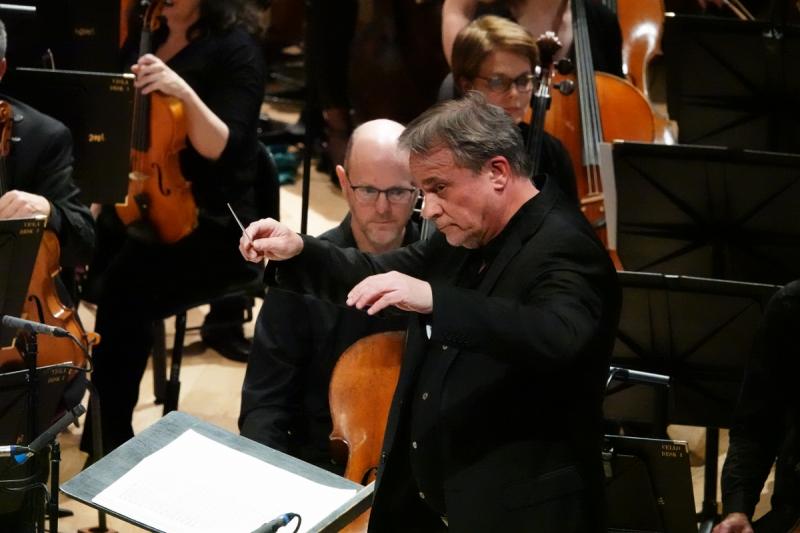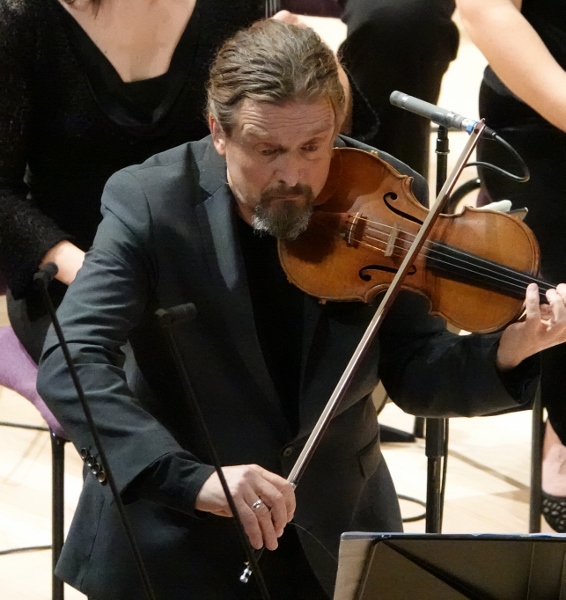Tetzlaff, BBC Philharmonic, Storgårds, Bridgewater Hall, Manchester review - something of a puzzle | reviews, news & interviews
Tetzlaff, BBC Philharmonic, Storgårds, Bridgewater Hall, Manchester review - something of a puzzle
Tetzlaff, BBC Philharmonic, Storgårds, Bridgewater Hall, Manchester review - something of a puzzle
‘Concentric Paths’ concerto fascinates as programme centrepiece

Chief conductor John Storgårds’ first programme of 2024 in the Bridgewater Hall was notable for the visit of Christian Tetzlaff as violin soloist, but perhaps a little puzzling in the choice of Thomas Adès’ Violin Concerto as the vehicle for his talents.
The concerto, sub-titled “Concentric Paths”, is a fascinating piece of orchestral composition but not the most obvious opportunity for a star soloist to engage his audience. And Bridgewater Hall attenders can hear Adès conducted by Adès in the Hallé’s series, too, now that he’s in post as artist-in-residence with them for two seasons.
Maybe we can’t get enough of him right now: it was certainly a warmly received performance, and Tetzlaff responded to the reception in the hall by picking up the score he’d just played from and pointing to it as a just object of adulation.
The concerto was itself the centrepiece of a programme that began with the charm of Prokofiev’s ballet music and ended with the serious weight of Shostakovich’s Symphony No. 1. Since it’s based on concepts of centrality and circular motion, that was the place to put it: indeed, its own second (and central) movement is its centre of gravity and the point where it attains, briefly, its most lyrical language. Much of the writing is, in typical Adès fashion, “full of noises” – exploring the extremes of pitch and varieties of colour obtainable from what is a classical-sized orchestra with some extra low brass and percussion, using the solo violin as one voice among many in the multi-part texture of the first movement and as one participant in a grand structure of repeating cycles (described as chaconne-like) in the second.
 It may come over differently on the radio, of course, as a soloist can as a result of microphone positioning. There was much for Tetzlaff (pictured left) to do, exploring the extremes of his instrument’s compass, and articulating its role against extremes of what might in any other context be thought of as an orchestra’s role of accompaniment. He accomplished this with technical brilliance and determination. The finale gave him more scope for conventional cantabile sound, along with the overlapping regular rhythmic patterns from the orchestra (its sub-title is “Rounds”), and that was beautiful. And, like with most rounds, the only way to make the music end rather than going on for ever is simply to stop. That’s what it does.
It may come over differently on the radio, of course, as a soloist can as a result of microphone positioning. There was much for Tetzlaff (pictured left) to do, exploring the extremes of his instrument’s compass, and articulating its role against extremes of what might in any other context be thought of as an orchestra’s role of accompaniment. He accomplished this with technical brilliance and determination. The finale gave him more scope for conventional cantabile sound, along with the overlapping regular rhythmic patterns from the orchestra (its sub-title is “Rounds”), and that was beautiful. And, like with most rounds, the only way to make the music end rather than going on for ever is simply to stop. That’s what it does.
The Prokofiev was his second suite from Cinderella, not the more familiar first one with the famous chiming clock effect, but featuring the Grand Waltz from the ball – usually the opportunity for lavish full-ensemble choreography when seen on stage – as well as the gentle opening of Cinderella’s Dreams (sweetly articulated by the Philharmonic strings), the Dancing Lesson and Gavotte (the two-violin duet delightfully played by leader Zoe Beyers and assistant leader Midori Sugiyama), the dances of the Spring Fairy and Summer Fairy, and other items, finishing with the Galop that accompanies the Prince’s frantic kingdom-wide search for a foot that will fit the abandoned slipper. It’s always good to hear this music performed by a concert-hall orchestra rather than coming from a theatre pit, and though the Grand Waltz as presented by Storgårds, with intriguing rhythmic irregularity and subtle articulation, might have foxed a corps de ballet if they’d tried to keep in time, it was great fun.
Before the Shostakovich symphony, we were treated to an unscheduled bonus from the conductor in the form of a Scherzo written by DSCH when he was only 17. It showed off some nice playing from principal clarinet (John Bradbury) and flute (Alex Jakeman), as well as Ian Buckle’s skills on the piano (also heard to great advantage elsewhere in the evening).
The symphony itself was done with a sense of gravity in the third and fourth movements that suited its seriousness of purpose and emotional firepower, despite the iconoclasm in the first and the Keystone-Cops dash of the second (brilliantly played by all concerned). The ending of that fast allegro was more an expression of irony than a simple joke, and, with very fine oboe playing from Jennifer Galloway and in the cello solo by Peter Dixon, the slow movement palpably gained in depth. The fourth continued this expressive impact, with the timpani solo, on three clearly different dynamic levels as played by Tim Williams, bringing drama to it, and the ending suitably ambiguous.
rating
Explore topics
Share this article
The future of Arts Journalism
You can stop theartsdesk.com closing!
We urgently need financing to survive. Our fundraising drive has thus far raised £49,000 but we need to reach £100,000 or we will be forced to close. Please contribute here: https://gofund.me/c3f6033d
And if you can forward this information to anyone who might assist, we’d be grateful.

Subscribe to theartsdesk.com
Thank you for continuing to read our work on theartsdesk.com. For unlimited access to every article in its entirety, including our archive of more than 15,000 pieces, we're asking for £5 per month or £40 per year. We feel it's a very good deal, and hope you do too.
To take a subscription now simply click here.
And if you're looking for that extra gift for a friend or family member, why not treat them to a theartsdesk.com gift subscription?
more Classical music
 Solomon, OAE, Butt, QEH review - daft Biblical whitewashing with great choruses
Even a top soprano and mezzo can’t make this Handel paean wholly convincing
Solomon, OAE, Butt, QEH review - daft Biblical whitewashing with great choruses
Even a top soprano and mezzo can’t make this Handel paean wholly convincing
 Two-Piano Gala, Kings Place review - shining constellations
London Piano Festival curators and illustrious friends entertain and enlighten
Two-Piano Gala, Kings Place review - shining constellations
London Piano Festival curators and illustrious friends entertain and enlighten
 Echo Vocal Ensemble, Latto, Union Chapel review - eclectic choral programme garlanded with dance
Beautiful singing at the heart of an imaginative and stylistically varied concert
Echo Vocal Ensemble, Latto, Union Chapel review - eclectic choral programme garlanded with dance
Beautiful singing at the heart of an imaginative and stylistically varied concert
 Scott, Irish Baroque Orchestra, Whelan, RIAM, Dublin review - towards a Mozart masterpiece
Characteristic joy and enlightenment from this team, but a valveless horn brings problems
Scott, Irish Baroque Orchestra, Whelan, RIAM, Dublin review - towards a Mozart masterpiece
Characteristic joy and enlightenment from this team, but a valveless horn brings problems
 Classical CDs: Voice flutes, flugelhorns and froth
Baroque sonatas, English orchestral music and an emotionally-charged vocal recital
Classical CDs: Voice flutes, flugelhorns and froth
Baroque sonatas, English orchestral music and an emotionally-charged vocal recital
 Kanneh-Mason, Britten Sinfonia, Shave, Milton Court - a grin and a big beaming smile
A pair of striking contemporary pieces alongside two old favourites
Kanneh-Mason, Britten Sinfonia, Shave, Milton Court - a grin and a big beaming smile
A pair of striking contemporary pieces alongside two old favourites
 theartsdesk at the New Ross Piano Festival - Finghin Collins’ musical rainbow
From revelatory Bach played with astounding maturity by a 22 year old to four-hand jazz
theartsdesk at the New Ross Piano Festival - Finghin Collins’ musical rainbow
From revelatory Bach played with astounding maturity by a 22 year old to four-hand jazz
 First Person: Manchester Camerata's Head of Artistic Planning Clara Marshall Cawley on questioning the status quo
Five days of free events with all sorts of audiences around Manchester starts tomorrow
First Person: Manchester Camerata's Head of Artistic Planning Clara Marshall Cawley on questioning the status quo
Five days of free events with all sorts of audiences around Manchester starts tomorrow
 Goldscheider, Brother Tree Sound, Kings Place review - music of hope from a young composer
Unusual combination of horn, strings and electronics makes for some intriguing listening
Goldscheider, Brother Tree Sound, Kings Place review - music of hope from a young composer
Unusual combination of horn, strings and electronics makes for some intriguing listening
 theartsdesk Q&A: composer Donghoon Shin on his new concerto for pianist Seong-Jin Cho
Classical music makes its debut at London's K-Music Festival
theartsdesk Q&A: composer Donghoon Shin on his new concerto for pianist Seong-Jin Cho
Classical music makes its debut at London's K-Music Festival

Add comment